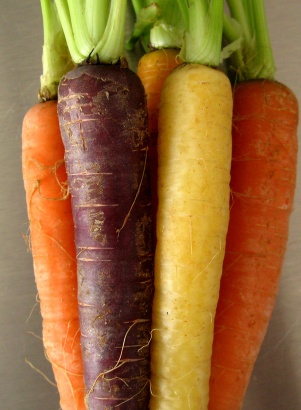The Weekender, April 30, 2021
Hi!
A long-time reader (hi, Herbert!) made a great suggestion this week: “I enjoy the returns because some of them I may have missed. Thought you might want to start with the first column you did. Probably most of your present readers never read it.” So, I’m going to do that… right now! Some quick thoughts about it afterward.
Carrots Were Originally Purple

Carrots are mutants.
Well, orange carrots at least. Originally, purple carrots were the norm, but there were some offshoots — yellow and white ones appeared in the wild. Over time, somehow, 17th-century Dutch carrot growers managed to cultivate these yellow and white carrots into the orange ones we are familiar with today.
The purple ones still do exist, but by far are the minority in the world of carrot colors. Want to try some? Beware — there may be a good reason why purple carrots are now the uncommon breed: the orange ones taste better. In fact, orange carrots may be a superfood of sorts when it comes to taste. A recent study showed that children said foods tasted better if favored cartoon character appeared on a box, with one food excepted: carrots.
Bonus: Eat too many carrots and beware: you may end up with carotenosis — a condition wherein excess beta carotene turns your skin orange-ish yellow.
That was the whole email. Short and to the point… but in retrospect, not very good. It gives the basic fact(s) but none of the background or history — it fails to answer the question, “but why?” And it turns out, in this case, there may be a pretty interesting “but why?” after all. Here’s a bit from an Economist piece:
There is a theory that orange carrots were promoted by the Dutch, who bred them in honour of William of Orange, the leader of a 16th-century revolt against the Spanish Habsburg monarchy that ruled over a swathe of north-western Europe. Whatever the truth of that particular idea, the orange carrot did eventually become associated with the House of Orange. According to Simon Schama, a historian, the conspicuous display of orange carrots at market was at one time deemed to be a provocative gesture of support for an exiled descendent of William, by the movement that drove out the monarch during the 18th century. But this contempt for orange carrots failed to inspire a consumer revolution: almost all modern European carrots descend from a variety originally grown in the Dutch town of Hoorn.
I’m not going to go back ten-plus years and revise the original story; I think it’s good to let my own newsletter’s history remain history. But it’s nice to know that the newsletter has come a long way since its early days.
(By the way, the carrot story isn’t the shortest Now I Know ever. That would be this one, the third one I ever published. It’s a bit of a miracle this newsletter made it out of its infancy.)
The Now I Know Week in Review
Monday: Four Weddings and a Divorce or Three. I love a good loophole story, and when I heard this one on NPR’s Wait, Wait, Don’t Tell Me, I knew I had to share it.
Tuesday: When Foxes Flew (Against Their Will). A sport that deserved to be lost to history.
Wednesday: One Spud, You’re Out. The best baseball story that has almost nothing to do with baseball, to the point that it barely involves a baseball.
Thursday: The Trees That Rock: A beautiful gesture from a broken heart.
And some other things you should check out:
Some long reads for the weekend. Sorry that some of these may be behind a loose paywall — as paywalls become increasingly common, I’m sharing more items that are gated, but I’m still trying to choose mostly accessible ones.
1) “The Squid Hunter” (The New Yorker, 27 minutes, May 2004). From the article:
The giant squid has consumed the imaginations of many oceanographers. How could something so big and powerful remain unseen for so long—or be less understood than dinosaurs, which died out millions of years ago? The search for a living specimen has inspired a fevered competition. For decades, teams of scientists have prowled the high seas in the hope of glimpsing one. These “squid squads” have in recent years invested millions of dollars and deployed scores of submarines and underwater cameras, in a struggle to be first.
Steve O’Shea, a marine biologist from New Zealand, is one of the hunters—but his approach is radically different. He is not trying to find a mature giant squid; rather, he is scouring the ocean for a baby, called a paralarva, which he can grow in captivity. A paralarva is often the size of a cricket.
[ . . . ]
Rival hunters once viewed his plan skeptically: if no one could find the animal when it was sixty feet long, how could anyone discover it when it was barely an eighth of an inch?
2) “Inside the bloody cartel war for Mexico’s multibillion-dollar avocado industry” (Los Angeles Times, 11 minutes, April 2021). “They wouldn’t be planting marijuana or other crops long favored by Mexican cartels, but something potentially even more profitable: avocados.” What a great sentence.
3) “The extraordinary life and death of the world’s oldest known spider” (Washington Post, 8 minutes, May 2018. Thanks to reader Holly M. for sharing this one. As the story states, “this is the story of the oldest known spider in the world and the people who knew her.” The spider was 43 years old when it died — so yes, that’s an old spider.
Have a great weekend!
Dan
